Miyamoto Musashi Budokan
The Miyamoto Musashi Budokan (a budōkan (武 道 館) is a dōjō (道場) where budō (武 道) is practiced, the word kan (館) means "house") built in the province of Mimasaka in Ōhara-Cho cradle of Miyamoto Musashi (March 12, 1584, Ōhara-Chō - May 19, 1645[1]) was inaugurated on May 20, 2000 the days after his anniversary date. This budokan is dedicated to the official martial arts of Japan. It brings together all the saber and kendo traditional schools. All Japanese martial arts are called to this precinct, the heart of traditional Japan. This budokan achieves the unification of martial disciplines not only in practice but also historically and culturally. The inauguration took place in the presence of many Japanese officials including Sensei Tadashi Chihara guarantor and tenth of the line of Miyamoto Musashi (who was at the initiative of the building), the mayor of Ōhara-Cho Fukuda Yoshiaki, Élisabeth Lamure mayor of Gleizé, and several saber and kendo schools representative of traditional and contemporary Japan.
宮本武蔵顕彰武蔵武道館 | |
Budokan | |
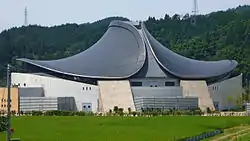 | |
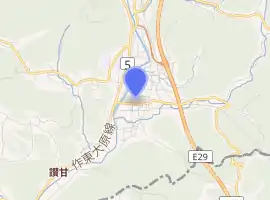
| |
| Location | Ōhara, Okayama, Japan |
|---|---|
| Coordinates | 35°5′52.67″N 134°19′35.32″E |
| Public transit | Chizu Express, Chizu line, Ōhara Station (Okayama), Miyamoto Musashi Station |
| Surface | 6049 m² |
| Construction | |
| Opened | May 20, 2000 |
| Architect | 沼田 亘さん - Wataru Numata |
Infrastructure
The main arena on the first floor can receive six kendo courts. The second floor contains 838 spectator seats. International kendo competitions are regularly organized there.[2]
- Main arena 1,376 m2 (42 m x 32 m), (139 ft x 105 ft)
- 6 kendo (11 m x 11 m), (36 ft x 36 ft)
- 2 volleyball
- 1 basketball
- 8 badminton
- Room dedicated to Budo 322 m2 (23 m x 14 m), (75 ft x 46 ft)
- 2 Kendo (9 m x 9 m), (29 ft x 29 ft)
- 2 Judo
Auxiliary facilities: training room, meeting room, fitness room, health / physical consultation room, rest room, equipment depot, changing rooms, shower rooms, room dedicated to broadcasting, offices
Architecture
The project was designed by Sensei Tadashi Chihara guarantor and tenth of the line of Miyamoto Musashi.[3] The architectural design of the Miyamoto Musashi Budokan was entrusted to Wataru Numata.[4][5]
The structure of the main arena surrounded by two floors above the ground is made of reinforced concrete. The total floor area is 6049 m2 (the first floor of 4252 m2 and the second floor 1797 m2). The building has been certified by Heart Building.
This Budokan represents a samurai helmet or kabuto symbol of the Okayama prefecture and recalls the label as well as the central personality of the Japanese culture and native of the country, Musashi.[6]
The delivery took place in May 2000 preceding the inauguration of May 20, 2000, in memory of the anniversary date of Miyamoto Musashi (March 12, 1584, Ōhara-Chō - May 19, 1645[1]).
Franco-Japanese link
The inauguration of the Miyamoto Musashi Budokan enabled the perpetuation of the twinning between the inhabitants of Ōhara (Japanese province of Mimasaka) and the inhabitants of Gleizé. On March 4, 1999, the village of Ōhara was twinned with Gleizé in the presence of Sensei Tadashi Chihara guarantor and tenth of the line of Miyamoto Musashi who notably carried the mandate of the mayor of Ōhara at the time Yuki Hiroshi, and in the presence of the mayor by Gleizé, Mrs. Élisabeth Lamure. Following an official presentation of martial arts, the “Miyamoto Musashi School” (Heiho Kadensho Niten Ichi Ryu) from Japan located in Ōhara-Cho proposes to make the Gleizé Dojo the main school of Miyamoto Musashi in the West and gives it the koryū (traditional school)[7] title. On Thursday March 4, 1999, this dojo officially acquired the name "Dojo Miyamoto Musashi".[8] The event continues with the official invitation of Japan to the newly elected mayor Fukuda Yoshiaki, with the subsequent visit of the mayor of Gleizé on May 20, 2000 to Ōhara for the inauguration of the Miyamoto Musashi Budokan and by the presence of a large delegation of Japanese authorities. The Heiho Niten Ichi Ryu Memorial located in Gleizé was established to promote and guarantee the memory of these relations as well as of the regions and countries which officially and successively joined them; Japan, France, Cambodia,[9] ASEAN,[10] Russia[11] and in parallel, the province of Mimasaka, the Rhône-Alpes region, the Center region and the Burgundy region. Each of the seventeen flags of the Heiho Niten Ichi Ryu Memorial floated successively in front of the façade of the Miyamoto Musashi Budokan in order to recall the close bond that unites the two communes. Similarly, in May of each year, several carp or koinobori (a symbol widely used in Japan) float at the memorial masts.
 the 10 th. Tadashi Chihara.
the 10 th. Tadashi Chihara.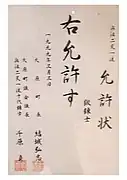 Twinning between Ōhara and Gleizé signed by Tadashi Chihara Sensei guarantor and tenth line of Miyamoto Musashi, and the Mayor of Ōhara, Yuki Hiroshi.
Twinning between Ōhara and Gleizé signed by Tadashi Chihara Sensei guarantor and tenth line of Miyamoto Musashi, and the Mayor of Ōhara, Yuki Hiroshi.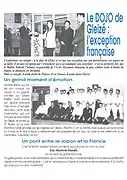 Official publication of the town hall of Gleizé - 1999. Sensei Tadashi Chihara guarantor and tenth of the line of Miyamoto Musashi, Élisabeth Lamure, and Ghislain de Longevialle.
Official publication of the town hall of Gleizé - 1999. Sensei Tadashi Chihara guarantor and tenth of the line of Miyamoto Musashi, Élisabeth Lamure, and Ghislain de Longevialle. Tadashi Chihara Sensei and Élisabeth Lamure during the transmission of the name of the school : the Miyamoto Musashi dojo in Gleizé represents the Miyamoto Musashi School in Japan.
Tadashi Chihara Sensei and Élisabeth Lamure during the transmission of the name of the school : the Miyamoto Musashi dojo in Gleizé represents the Miyamoto Musashi School in Japan.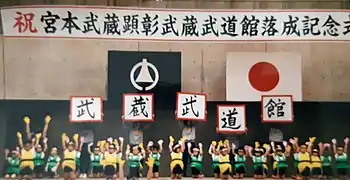 Inauguration of Miyamoto Musashi Budokan.
Inauguration of Miyamoto Musashi Budokan.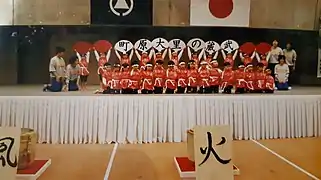 Inauguration of Miyamoto Musashi Budokan.
Inauguration of Miyamoto Musashi Budokan. Élisabeth Lamure wears the Japanese cockade during her speech at the inauguration of the Miyamoto Musashi Budokan in Ōhara, Mimasaka province on May 20, 2000.
Élisabeth Lamure wears the Japanese cockade during her speech at the inauguration of the Miyamoto Musashi Budokan in Ōhara, Mimasaka province on May 20, 2000.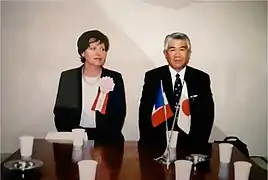 Master Moriwa and Élisabeth Lamure during the inauguration of Miyamoto Musashi Budokan.
Master Moriwa and Élisabeth Lamure during the inauguration of Miyamoto Musashi Budokan. Inauguration of Miyamoto Musashi Budokan.
Inauguration of Miyamoto Musashi Budokan.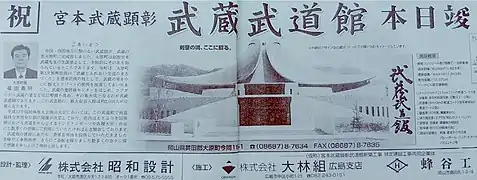 Mayor of Ōhara-Cho about the Miyamoto Musashi Budokan
Mayor of Ōhara-Cho about the Miyamoto Musashi Budokan Japanese article from 2005.
Japanese article from 2005.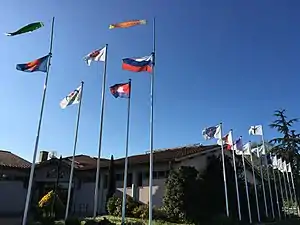 The Heiho Niten Ichi Ryu Memorial has been ensuring the sustainability of the twinning between Ōhara and Gleizé since December 8, 2014.
The Heiho Niten Ichi Ryu Memorial has been ensuring the sustainability of the twinning between Ōhara and Gleizé since December 8, 2014. Carps and flags of which those of Japan, Mimasaka and the Holy Spirit in front of the Miyamoto Musashi Budokan façade of honour.
Carps and flags of which those of Japan, Mimasaka and the Holy Spirit in front of the Miyamoto Musashi Budokan façade of honour.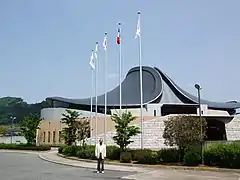 The 10th. Tadashi Chihara.
The 10th. Tadashi Chihara.
Access by transport
Chizu Express, Chizu Line, Miyamoto Musashi Station 10 minutes on foot.
- Views of Miyamoto Musashi station


References
- Tokitsu, Kenji (1998). Miyamoto Musashi: 17th century Japanese saber master: man and work, myth and reality ; Miyamoto Musashi : maître de sabre japonais du XVIIe siècle : l'homme et l'œuvre, mythe et réalité. https://www.worldcat.org/oclc/41259596: Editions désiris. pp. 19, 20. ISBN 9782907653541.CS1 maint: location (link)
- "宮本武蔵顕彰武蔵武道館 - Miyamoto Musashi Budokan". Archived from the original on 2015.
- "the 10 th, Tadashi Chihara, hyouhou niten ichiryū musashi seitannochi" (PDF). April 11, 2020.
- "建築家資格制度 - Institute of Japanese Architects". July 3, 2020.
- "昭和設計 代表取締役社長, 沼田 亘さん - Showa Design President, Wataru Numata". July 3, 2020.
- "武蔵の里の武道館 - Musashi no Sato Budokan". July 3, 2020.
- "Reportage - Dojo - France3 - Miyamoto Musashi School". February 1999.
- "Heiho Niten Ichi Ryu Memorial". 2018.
- "Le Cambodge à l'honneur". Le Progrès. 13 December 2015.
- "Un pont symbolique vers l'Asie". Le Progrès. 12 December 2015. Archived from the original on 20 January 2016.
- "La Russie et l'ASEAN à l'honneur". Le Progrès. 12 February 2017.
- Translated from Wikipedia articles, 宮本武蔵顕彰武蔵武道館 and Budokan Miyamoto Musashi